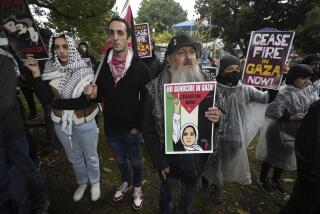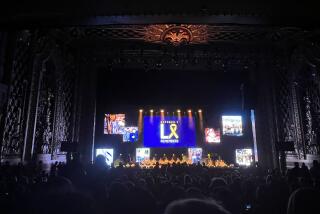Creating partnerships at Seder
The maror looked strange to immigrant rights activist Angelica Salas, and she wasn’t sure how bitter the bitter herbs would be.
“But I actually really enjoyed it,” Salas said, recalling how she dipped parsley into saltwater and made her first Hillel sandwich at her first Passover Seder.
Stuffing charoset, a paste of sweet fruits and nuts, and a layer of bitter herbs between two small pieces of matzo bread, Salas laughed as the flatbread crunched and crumbled between her teeth.
“The singing, the poems and the prayers by others were really welcoming, and even if you weren’t Jewish, you really felt welcome. And even if this isn’t your faith and your tradition, there was a message,” said Salas, executive director of the Coalition for Humane Immigrant Rights of Los Angeles.
She was among more than 80 people at the Nation of Immigrants Passover Seder held this month by the local Anti-Defamation League at Wilshire Boulevard Temple. It was one of scores of outreach Seders held this year by Jews celebrating Passover, which officially began at sundown Saturday.
“As Jews, we are always looking for partners in the community that will stand up against anti-Semitism. How do we achieve partnership if we aren’t willing to stand up for others ourselves?” said Amanda Suskind, regional director of the ADL. “It actually helps to foster this coalition of people. If all the minorities stand up together, what a great majority we will be.”
Some Seders, the ritual meal that recounts the Exodus of Jews from Egypt, were held even before Passover officially began. The American Jewish Committee held a Seder at the Wilshire temple on Thursday, celebrating the historical alliance between Jews and blacks.
Another Seder at Wilshire Boulevard Temple on Saturday will be dedicated to building stronger relationships between Jews and Muslims. At that Seder, the Passover story will be told through the Koran, which also recounts the Exodus. And the Progressive Jewish Alliance is having a Seder on May Day, May 1, that will bring together Jews and the labor force.
“There is a way in which sharing this holiday is an important way of sharing something very vital in the Jewish tradition,” said Rabbi Haim Beliak, who will be joined for Seder at his house by Shakeel Syed, executive director of the Islamic Shura Council of Southern California.
“The nature of the Seder, because of its enduring message of freedom, lends itself to an important discussion. The question of what freedom means and how we achieve liberation is not something that you can ever finish talking about,” Beliak said.
Daniel Espiritu of the Philippine Consulate in Los Angeles said the Exodus is a tale that resonates across many faiths and peoples. He brought his family to the Nation of Immigrants Seder, and together they observed the tradition of dipping their pinkies into wine or grape juice for each of the 10 plagues.
“The inspiration that comes from this story is so strong,” Espiritu said. “If such celebrations are popularized more and more, it can create greater understanding between people in Southern California.”
Many Jews look to the Freedom Seder, celebrated in 1969 in Washington, D.C., as a turning point in the way American Jews celebrate Passover. Hundreds of Jews and African Americans gathered for the event, which was designed to commemorate the legacy of Martin Luther King Jr. a year after he died. The Haggadah, the traditional text guiding the Seder, was transformed to address current issues, such as civil rights, and to include alternative voices, such as beat poet Allen Ginsberg.
“The Freedom Seder kind of freed the Seder,” said Rabbi Arthur Waskow of the Shalom Center in Philadelphia, who organized the 1969 gathering.
“The moment was there, the need and the desire among many, many Jews to be able to draw on the best of Jewish tradition and to be able to also say what was on their own hearts and minds,” Waskow said in a telephone interview.
According to the Haggadah, “in every generation, every human being must look upon himself or herself as if they are going through slavery to freedom. For the first time, that line rose off the page and became real,” Waskow said. After the Freedom Seder, “the result was that within a year or two, there was a wave of other liberation Haggadahs.”
Adrian Dove, president of the Los Angeles County Commission on Human Relations, went to the African American and Jewish connection Seder on Thursday night. He and a group of African American and Jewish leaders had just returned from a trip to the South, where they toured memorials of the civil rights struggle, including the 16th Street Baptist Church in Birmingham, Ala., and King’s grave in Atlanta.
“Back in the ‘60s when we were marching in Selma and Birmingham, what we noticed was that it seemed like all the whites that were there supporting us happened to be Jews,” Dove said. By going on the trip and attending the Seder, Dove said, he hoped to renew the alliance between African Americans and Jews.
In each group’s story of liberation, “there are so many parallels,” Dove said.
After the wine and before the blessing of the food Thursday night, Rev. Brenda Lamothe of the First African Methodist Episcopal Church, Rabbi Stephen Julius Stein of Wilshire Boulevard Temple and Randy Brown of the American Jewish Committee read an adaptation of Michael Walzer’s “Exodus Revolution.”
The passage has been a theme of outreach Seders.
“Wherever we live, it is probably Egypt. There is, there really is, a better place, a promised land. And there is a promised time,” the three said. “And there is no way to get from here to there, from now to then, except by joining together and marching -- and sometimes stumbling -- through the wilderness, watching this time not for signs and wonders but for an opportunity to act.”
--


